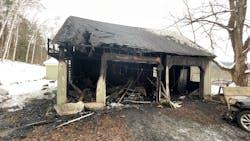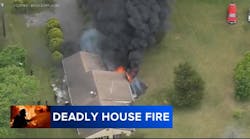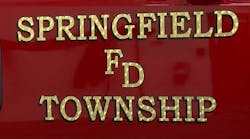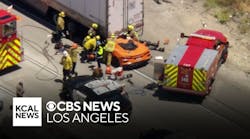On Dec. 17, 2022, a first alarm of fire was transmitted for a residence in Lyme, NH. Shortly after companies arrived, a smoke explosion occurred, which briefly separated the interior attack crew. Multiple maydays were transmitted. Forcible entry occurred, allowing the members to quickly be reunited.
Our thanks to Chief Aaron Rich of the Lyme, NH, Fire Department (LFD) and the homeowners for their willingness to share incident information, to Capt. Josh Merriam of the Hanover, NH, Fire Department (HFD) for his cooperation in providing the account and to all of the members who responded to the after-action report questionnaire.
The response
The LFD is a small, volunteer department. It was first due with an engine and a tanker. Both had limited staffing. The HFD is a career department, with a daily shift staffing of five personnel. Additionally, a deputy chief and a fire chief work weekdays. HFD Engine 4 was second due.
The normal response to Lyme would be with a single engine. However, a recent winter storm necessitated a recall for HFD personnel, which provided additional members on various apparatus. (Automatic aid agreements are in place.)
Account from Merriam
Two lines were stretched almost simultaneously from LFD Engine 2. The first 1¾-inch line was operated by an LFD firefighter, who was directed to apply water to the visible fire that was coming from the garage. This line was taken over by HFD Firefighters Christopher Sweitzer and Thomas Trimarco as soon as they were on air for an offensive attack. The second 1¾-inch line was operated by HFD Firefighter Helder Ferreira. He began to knock down the fire from the Bravo side of the garage under the direction of HFD then-Lt. John Emerson (now captain). Emerson’s plan was to hit the large volume of fire from the exterior as the interior line was advanced for an offensive attack. This hoseline would be shut down once the interior attack was launched.
The interior line was moved through the breezeway, taken through a 180-degree turn and then was moved back down a hallway toward the garage.
When interviewed after the fire, Sweitzer and Trimarco reported limited visibility and low heat conditions.
As the hoseline was advanced by Sweitzer and Trimarco, a smoke explosion occurred in their vicinity.
This free-burning garage fire, with extension into the house just beginning to occur, appeared routine. The smoke explosion caught the members who were on scene completely off guard; no one was mentally prepared for it. It was an incredible experience for those who were involved and hammered home the reality that there’s no such thing as a routine fire.
Smoke explosion
The blast blew off Trimarco’s helmet and disoriented him in the entryway. The interior door through which the hoseline passed was blown shut. This jammed the hoseline in the doorway and cut off water to Sweitzer.
Sweitzer reported that he heard the explosion and described what sounded like a door slamming. He remained oriented to his surroundings and could make out light that was coming from windows that were in his vicinity. Although he noted fire above his head, he opted to stay on the line and back out.
Emerson immediately broadcasted a mayday, as he recognized the change in conditions and the door being inoperable.
After no response, he was directed to work with Trimarco to get the door opened.
Merriam, who arrived with HFD Firefighter Christopher Mielewski shortly before the explosion occurred, attempted to contact Sweitzer without success and transmitted multiple maydays. Within a minute of the smoke explosion, the door was forced open. Sweitzer was located uninjured on the other side.
Sweitzer and Trimarco regrouped and advanced the hoseline back into the structure for extinguishment. It was noted that multiple windows throughout the structure, and even frame assemblies, were damaged from the event.
No RIT was established at the time of the smoke explosion. Although it sounds archaic, rarely do departments that are in the region have the staffing for a RIT at fires. Those who can work are working.
Because the explosion happened very early in the incident—and as a result of the larger-than normal response—personnel still were organizing into companies when the explosion occurred.
HFD Chief Martin McMillan (designated incident commander), Merriam (assigned to operations) and Emerson (eventually designated as Division 1) hadn’t made it very far onto the fireground when the smoke explosion occurred.
The remaining firefight played out routinely and successfully.
A 360-degree size-up was completed, which confirmed a garage fire with potential for extension to the house.
Vertical ventilation was directed above the breezeway to limit horizontal fire spread into the house. The ceiling in the breezeway couldn’t be pulled easily; plywood was found above the drywall.
Water supply was established and maintained during the duration of the incident.
Utilities were controlled, and salvage operations within the house occurred.
The response to the fire reached three alarms, with the third alarm requested for additional tankers.
What went well
• The first-arriving apparatus was LFD Tanker 1, which was positioned to the left of the driveway. This allowed LFD Engine 2, arriving just after, to have good positioning for fire attack.
• The initial size-up was detailed, which resulted in additional resources being requested immediately.
• Additional incoming units were directed to back into the long, narrow roadway. This allowed for a supply line to immediately be laid to the bottom of the hill for tanker operations.
• Hoseline deployment (three 1¾-inch handlines) and placement stopped fire extension into the house.
• Water supply was established early and was uninterrupted.
• Vertical and horizontal ventilation was coordinated with fire attack.
• A significant storm in the region provided more personnel than normal, with a shorter response time.
• Significant property conservation.
• There were no physical injuries.
Lessons learned/reinforced
• Because of the number of personnel who arrived on multiple apparatus, the initial scene was confusing. Clearer division of duties and accountability for initial operations is recommended.
• Interior attack shouldn’t have been initiated prior to the 360-degree size-up.
• No personnel with forcible entry tools initially were involved. If the interior door was of different construction, this could have delayed reentry significantly.
• Inadequate pump discharge pressure allowed for the door to be blown shut on the interior-deployed hoseline. This presents an opportunity for more pump operator training.
• All interior firefighters must have a portable radio.
• PPE must be ready to go all of the time.
• The lack of radio discipline in the Upper Valley of New Hampshire is recognized widely and frequently discussed. This must be addressed in conjunction with mutual aid. Multiple maydays were transmitted on two channels and only were heard by a few personnel. Command never heard them.
• There was confusion on the fireground channel. Personnel were operating on OPS2 and on TAC2. Discussion is needed on the administration of channels. Practice like you play.
• Consider pausing and evaluating the situation before declaring a mayday. Collect your thoughts, remain calm and have a plan. Sweitzer was OK and able to communicate. The assumption from the outside was worst-case scenario.
• Remember your emergency alert button on your portable radio. If you can’t get out on the operations channel, you might need to change to the dispatch channel.
• Training that involves HFD dispatch for events such as a mayday should occur.
Fire science
A backdraft requires a high concentration of fuel gas/vapor, a low concentration of air and a temperature that’s above the ignition temperature of flammable products of combustion and pyrolysis products. A smoke explosion requires a mixture of fuel (smoke) and air within the flammable range below the ignition temperature of flammable products of combustion and pyrolysis products. Smoke from an underventilated fire can flow through leakage that’s in a structure or building to collect in concealed spaces or other compartments. Remember, smoke is fuel. If smoke is present, even if cool and well away from involved compartments, there’s potential for a smoke explosion.
Personnel who were on scene observed smoke emitting throughout the structure. Upon entering, the initial attack crew reported white colored smoke, limited visibility and little to no heat. Based on the witnessed explosion, reports from the interior crew and the damage to the structure, it’s believed that a smoke explosion occurred. This was the result of the byproducts of combustion being within a flammable range and finding a source of ignition.
Comments from Goldfeder
Often, a smoke explosion, a backdraft and a flashover are confusing and misunderstood. Their common denominator: They can lead to devastating outcomes. As the contents and modern construction of structures and buildings continue to contribute to these events, we will continue to see these rapid and dangerous fireground events. That doesn’t mean that we don’t do this or that. It means that we keep learning, with the understanding that water maximizes the chances of victims’ survival and of us to have positive outcomes.
UL’s Fire Safety Research Institute (FSRI) is researching backdrafts and smoke explosions. The line between these two events isn’t as clear as one might like. Currently, NFPA 921: Guide for Fire and Explosion Investigations notes that the two phenomena are the same. Incidents where we might have thought that there was a smoke explosion because no one was venting actually might have had a backdraft, because the fire itself changed the ventilation. FSRI just submitted a journal article for peer review to see what other scientists believe. In the article, FSRI introduces another term, overpressure event, which encompasses backdrafts, smoke explosions and the type of fire behavior that was witnessed at the 2020 Toy District Fire that injured 11 Los Angeles City Fire Department firefighters.
Lastly, in relation to the fire that’s the subject of this column, here are points for consideration by all firefighters and fire officers:
Operating on the fireground without a 360-degree size-up (when applicable) is like going on a blind date: You have no idea what you’re getting into. Do the 360 size-up. In 2024, it should be unquestionable and should be policy, with the appropriate report.
Consider your first alarm and the staffing adequate to handle all potential tasks, including civilian and firefighter rescue. Are enough firefighters responding to cover water supply, forcible entry, search, stretching and moving hoselines, victim rescue, ventilation and all of the other tasks that we predictably perform 100 percent of the time on the fireground? Consider your fireground as you would look at a football team: You need a determined number of players on the field and many players on the bench “just in case.” If your mutual aid departments are located far away, call them sooner. You always can send them back.
Strict fireground discipline, where every company understands its assignment and does it without question, is required.
Firefighters and officers, never get off of the rig without the needed tools or lines. Chiefs, never arrive without being geared up fully, with the tools to do command, accountability, radio, light, worksheet, etc. If you are in command, it’s best that you are stationary—even better, in a vehicle so you can focus, in the same way that a pilot focuses on flying—in other words, without others causing distractions. If you are in an area where staffing requires command to also perform tasks, that can be solved with heavier first alarms. The coach can’t play in the game with a winning expectation.
Clear understanding of radio use is vital. What channel or talk group? When this can be standardized regionally, fires go better.
Dispatchers are integral to fireground operations. Include them in all applicable policies (including maydays) and invite them to trainings (classroom and hands on), so they can practice their responsibilities as part of the team. An engaged, trained and qualified dispatcher is a blessing to the incident command.








